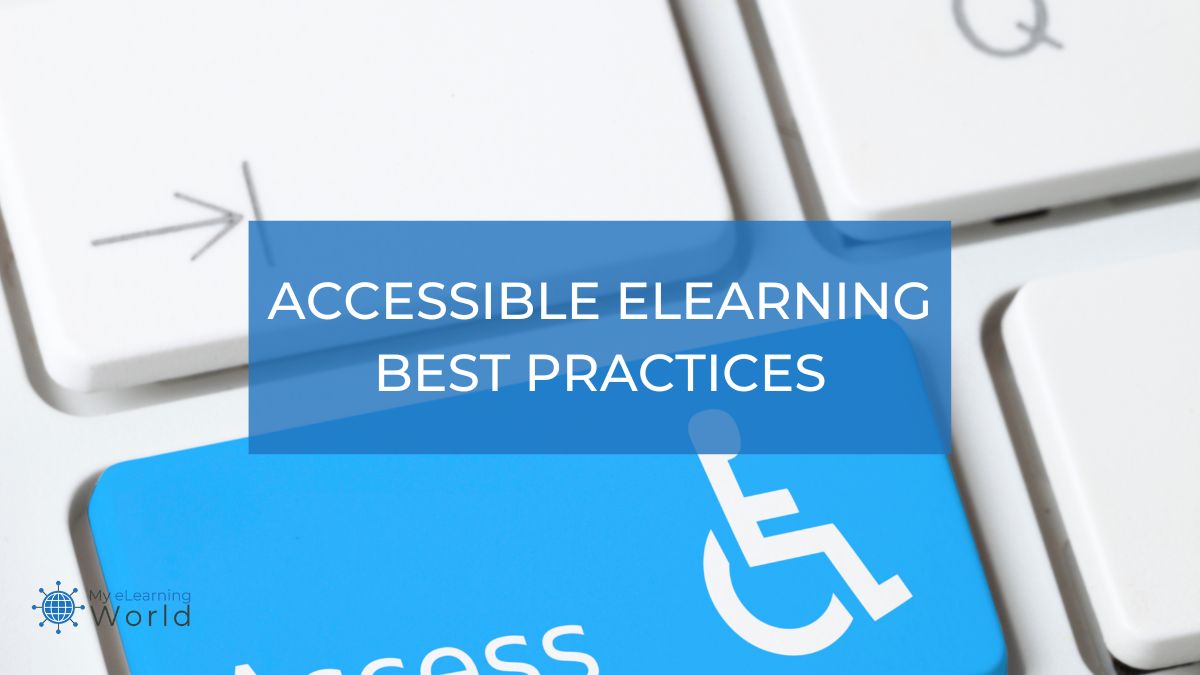Did you know about 13% of Americans have a disability? Creating accessible eLearning is more than just a good practice, it’s a necessity. But accessibility in eLearning goes beyond just making content available online. It’s about ensuring that all learners, including those with disabilities, have equal access to educational content. This means designing eLearning courses that cater to a wide range of needs, from auditory and visual to mobility and cognitive challenges.
Why does eLearning accessibility matter? It’s about inclusivity—making sure that every learner has the opportunity to succeed. You want your course to be user-friendly and navigable for everyone, so learners of all types can enjoy a quality learning experience.
If you’ve ever wondered whether your online courses are truly accessible, I’m going to talk about what accessible eLearning really means and how it can be achieved so you can improve your course creation process.
How to Create Accessible eLearning Experiences
As an instructional designer, I can tell you there are many different things you need to consider when creating accessible eLearning content.
Visual Accessibility
Being visually impaired is one of the biggest challenges a learner can face. About 20 million Americans are estimated to have a visual impairment.
To help students with vision disabilities, eLearning platforms have elements such as screen readers and text to speech functionalities that are forms of assistive technology.
They also allow users to adjust the interface so that both contrasts is high in color for easy sighted reading.
These tools give visual disadvantaged individuals the opportunity to explore the content, find written information, and interact with different media elements.
- Use audio descriptions–Audio descriptions have immense benefits in terms of accessibility to improve perception and understanding. Describing the visual elements of videos or images included in this type of instruction allows every learner to understand what one means with a message bringing an inclusive learning environment.
- Incorporate adaptable interfaces–Adaptable interfaces strive to provide an environment that is inclusive and easy-to use by enabling users to customize the digital user interface based on personal demands. This approach takes into consideration the varying learner population and understands that design for implementation to a monadic universal principle may not be valid for all learners. Through infusing adaptability into the eLearning interfaces, developers can promote a friendlier and comprehensive learning environment for all its users.
Auditory Accessibility
Nearly 40 million Americans have trouble hearing, so it’s an important consideration in eLearning design.
By using subtitles, closed captions, and transcripts, audio content becomes more accessible even for deaf learners who have a seamless flow while interacting with the material.
Having written transcripts that accompany audio content provides the learners who are hearing impaired to have an opportunity of reading what was also said out loud. And captions and subtitles help to improve the readability of videos so that video content will be available for more viewers.
Motor Accessibility
Motor disabilities can range from mild difficulties with fine motor skills to more significant challenges such as limited use of limbs or reliance on assistive technologies.
To accommodate these learners, eLearning designers should implement navigational and interactive elements that are easily operable. This includes keyboard-friendly navigation for those who cannot use a mouse, customizable interfaces that allow users to adjust control settings, touch screen functionality, voice commands, and giving sufficient time for completing tasks without feeling rushed.
By thoughtfully designing eLearning content with motor disabilities in mind, educators can create a more inclusive learning environment that empowers all learners to achieve their full potential, regardless of their physical abilities.
Cognitive Accessibility
Considering cognitive accessibility in eLearning involves creating content that supports learners with cognitive disabilities, such as dyslexia, ADHD, and autism spectrum disorders.
This means designing courses that minimize cognitive overload, use clear and simple language, and present information in a structured and predictable way.
To enhance cognitive accessibility, it’s essential to break down complex concepts into smaller, manageable chunks (think microlearning) and use consistent navigation and layout throughout the eLearning materials.
Visual aids like diagrams, charts, and infographics can help illustrate key points and make abstract concepts more concrete and accessible.
Additionally, providing multiple means of representation, including text, audio, and video, caters to diverse learning preferences and needs, aiding comprehension and retention.
Interactive elements, such as quizzes and interactive scenarios, should be designed to allow learners to proceed at their own pace, offering feedback that is constructive and encouraging.
The Impact of Accessibility on Learning Outcomes
Focusing on accessibility in eLearning isn’t just a compliance issue, it’s something that impacts the outcomes of learning as well as the overall educational experience. Prioritizing inclusivity in educational content brings benefits not to the learners with disabilities only but to the whole student population.
- Improve retention and engagement–If you really think about it, it’s just common sense – content that is accessible to all will be more interesting and engaging for every learner.
- Enhance collaboration–Inclusive design encourages a participatory manner among a diverse population of students and stimulates them to exchange ideas and opinions freely.
- Foster a positive learning environment–By emphasizing accessibility, eLearning platforms build a welcoming environment and promote positive outcomes. Such inclusivity creates empathy and better understanding of the unique needs within the community.
- Meet legal and ethical obligations–With the growing attention given to accessibility in eLearning, emerging legal and ethical frameworks serve as guidelines for educational institutions and content producers. Several states have even come up with their accessibility standards – the Web Content Accessibility Guidelines (WCAG) ensuring that digital media is accessible to everyone. Such compliance has not only to correspond with the law but is also an expression of obligation for maximized educational support.
Other Useful Resources
- How to Make Better Online Course Videos
- How to Use AI When Creating eLearning Videos
- Best Practices for Making eLearning Videos
- How to Make Your eLearning Videos Accessible for All
- Tips for Creating a How To Video
- Interactive Video Learning
Final Thoughts
Designing eLearning with accessibility in mind enriches the learning experience for everyone.
By considering the diverse needs of all learners, including those with disabilities, you can create more engaging, effective, and universally accessible educational content.
Let’s embrace accessibility and make it a priority with our eLearning design, ensuring that every learner has the opportunity to succeed and thrive.

